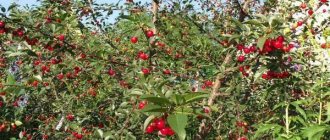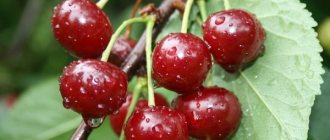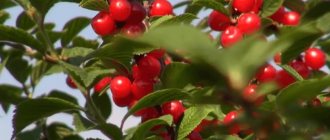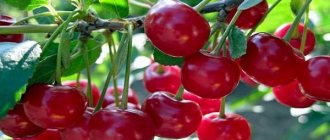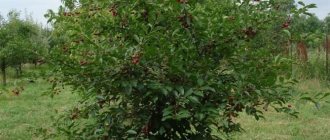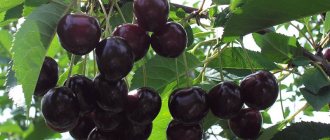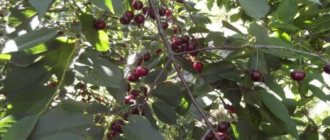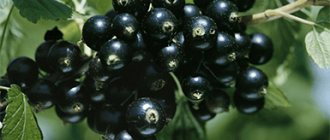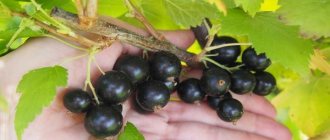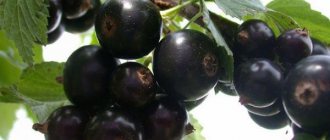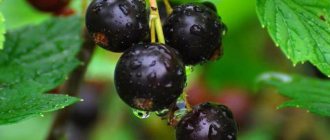Cherry Morel Bryansk (Amorel, Morello) - description of the variety
Morel is an old European cherry variety that came to Russia from Holland, where it was bred in the 18th century.
It has several common subspecies, including Morel Bryanskaya, Nefris, Lotovka - these varieties were included in the State Register in the twentieth century. Morel is very popular among gardeners and is grown for sale raw, as well as for making various compotes, jams and even wine. In this material we will analyze what the features of this variety are, what varieties there are, how to properly plant Morel on your site and care for cherries in order to get a good harvest every year.
Description and characteristics of the variety
This cherry variety (depending on its variety) can be represented by both shrubs and low trees with spreading crowns. It has the following features:
- Tree. Low - the plant reaches an average height of 1.5 meters, sometimes 2 meters. It has a wide spreading crown with a large number of leaves. The branches of the trunk are ashen-light, the shoots are brownish with a silvery coating. The leaves are medium in size, reaching 7 cm in length. The flowers are small, up to 27 mm in diameter, collected in inflorescences of 4 pieces.
- Fruit. Large (weighing up to 3 grams), thin-skinned, ruby-colored, have elastic, juicy pulp. Their taste is sweet and sour.
The presented species begins to bear fruit from the 3rd year of life. 10-year-old plants have the maximum yield. In the future, the plant's productivity will gradually decrease if rejuvenating pruning of the cherry is not carried out.
Morel cherry - variety description, photos, reviews from gardeners
Despite the fact that many varieties of cherries have been developed that take root and bear fruit not only in Ukraine, Moldova, the southern regions of Russia, but also in the central regions, black cherries do not give up their position.
Sweet and sour berries are used for compotes for the winter, aromatic jams and preserves are prepared, which are much tastier than cherries.
Hybrid cherries with large juicy fruits were developed through selection by Voronchikhin, crossing different types of garden crops.
Black cherry varieties
The tree grows 4–5 meters in height and forms a wide pyramidal crown. The leaves are attached to thick petioles, and flowers appear in the third year of planting. At the end of July, dark-colored berries weighing about 6 g ripen on the branches of black cherry. More than a dozen varieties of this variety of garden plant are cultivated.
Cherry Vladimirskaya
In the Middle Volga region, in the central regions of North-West Russia, in the Volga-Vyatka region, a tall and self-sterile variety - Vladimir cherry - has been planted for a very long time. The tree tolerates cold winters normally, but frosts, which often occur in May, cause the flowers to fall off and die.
The black-red berries, with dense, aromatic pulp, ripen by the end of July. Small bones separate well. With proper care and favorable weather, the tree will ripen about 20 kg of sweet and sour berries. The plant is often affected by fungal diseases and bears fruit for up to 15 years if planted next to cherry trees that bloom at the same time.
Griot Rossoshansky
In the North Caucasus and the Lower Volga region, a stone fruit variety that is not afraid of rot and produces a stable harvest takes root well, which increases if other black cherries grow nearby. From a tree about 6 meters high in the last days of June, 15–16 kg of berries are collected, which differ:
- sweetish taste;
- beautiful dark skin;
- juicy and tender pulp;
- garden aroma.
Cherries of the Griot Rossoshansky variety are poorly transported, but are suitable for making jams and compotes. The plant is often subject to coccomycosis; repeated spraying with fungicides helps prevent the disease.
Cherry Zhukovskaya
Trees of this variety begin to bloom and delight with large berries already in the fourth year after planting. The flesh of the fruit is black. The advantages of Zhukovskaya cherries include:
- high yield - up to 3 buckets per tree;
- excellent taste;
- excellent transportability;
- resistance to major diseases.
One berry weighs about 7 grams, and the tree bears fruit for two decades, but the inflorescences fall off even with slight frosts.
Rossoshanskaya Black
Both in the favorable climate of the North Caucasus, the Lower Volga region, and in the harsh conditions of Siberia and the Trans-Urals, a self-fertile variety of stone fruit crop, the Rossoshanskaya Black cherry, takes root. The first berries appear on a three-year-old tree; an adult plant produces a harvest of 15 to 25 kg. Although the flowers form late, the fruits ripen as early as June.
Cherries look very beautiful, have a rich brown color, and the pulp is very pleasant to the taste. From berries that are normally transported, aromatic compotes are obtained.
Black Large
The hybrid cherry, which appeared with the participation of the Russian breeder Voronchikhin, is a low tree with a dense crown and long shoots. The bark of the plant is dark brown in color, and the leaves are glossy, with small teeth along the edges.
A large cherry berry has:
- thin skin;
- juicy pulp;
- rich color;
- sweet and sour taste.
Some specimens weigh 8 g. The tree begins to bear fruit at the age of four. Cherries ripen in the last days of June, do not spoil in the refrigerator for about 2 months and are used for freezing, drying, making compotes and jams.
The variety has not only advantages, but also disadvantages. The tree lives less than 20 years and is affected by fungi.
Morel Bryanskaya
This variety of cherries was developed in the Netherlands more than 2 centuries ago. Depending on the variety, it can grow both as a shrub and as a tree with a lush crown. Morel is planted in country houses and gardens. The unpretentious crop tolerates cold winters well and does not suffer from fungal diseases or most pests. Such varieties are sprayed with insecticides only once per season.
Morel Bryanskaya is grown on an industrial basis in the Central region.
The description of the variety attracted interest from farmers. Cherries delight with sweet berries that are dark red in color and have dense pulp. Picking fruits and trimming branches is quite convenient, since the tree does not stretch upward. The plant blooms at the end of May, when frosts are rare, so it will reward you with an excellent harvest for proper care.
Consumer goods Black
The short, beautiful cherry, whose slightly flattened berries seem to be covered with varnish, does not lose popularity. The variety called Shirpotreb Chernaya was bred in a nursery founded by Ivan Michurin at the beginning of the last century.
The first fruits on the tree are set in the second year after planting in the ground. Cherries ripen in July, differing in:
- tender and durable pulp;
- sweetish taste;
- presence of sourness.
The berries are completely black, weigh about 4 g, and are located on a long stalk. The yield of the variety increases if cherries grow nearby - Vladimirskaya or Zhukovskaya. The tree does not tolerate cold winters well and suffers from May frosts.
Memory of Voronchikhina
When crossing Spectacular and Prima, Russian breeders at the beginning of the 2000s created a new variety of black cherry, which was named after one of them. The tree, up to 5 meters high, has a spreading crown, straight shoots with large buds, and thick oval-shaped leaves.
Dark cherry berries weigh a little more than 5 g, the pulp has the same color, and the skin is dense. The bone is difficult to separate.
The Memory Voronchikhina variety bears fruit in the third year; under favorable conditions, 2 to 3 buckets of berries ripen on the tree. Cherries are cultivated in the Central Black Earth region.
In cold winters, the plant practically does not freeze and is rarely affected by moniliosis. The trees bloom early, the berries ripen by the end of June.
Chocolate girl
Several decades ago, Russian scientists, based on two varieties Lyubskaya and Shirpotreb, developed cherries that are not afraid of frost, bear fruit from the age of three, and are highly transportable, which allows them to be grown for industrial purposes.
The dark red, almost chocolate-colored berries contain more than 12% sugar and less than 2% acid. The stone is easily separated from the pulp.
The tree, about 2.5 m high, has a compact and attractive crown and blooms after May 15th. The advantages of Shokoladnitsa cherries include:
- drought resistance;
- self-fertility;
- excellent presentation;
- pleasant taste.
The plant feels good on illuminated slopes, loves fertile light soil, and does not tolerate acidic soil where water stagnates. The variety often suffers from diseases that affect stone fruit crops.
Anthracite
Small cherry trees with a spreading crown decorate dachas and suburban areas in the central regions of Russia.
The heart-shaped and jet-black berries weigh up to 5 grams and are valued for their sweet and sour taste and for the fact that the seed can be separated from the juicy pulp without any problems. Anthracite cherry cannot boast of high productivity.
The fruits ripen in the last ten days of July, are suitable for making compotes and jams, do not wrinkle during transportation, and do not lose their presentation.
Features of planting black cherry
In order for stone fruit crops not to be affected by diseases and to delight them with sweet and large berries, it is necessary to comply with agrotechnical requirements for care and planting. Be sure to pay attention to choosing a place where the black cherry will be comfortable. Trees do not like shade; they must be protected from drafts and piercing winds.
Seedlings are sent to prepared soil at the very beginning of spring, before the buds wake up after the winter cold. After digging up the ground, they add organic matter; it needs about 15 kg per square meter. m. The hole should be made to a depth of 50–60 cm and a width of up to a meter.
Before planting, the tree is sent into water with “Kornevin”, where it is kept for about 10 hours. Cherry varieties should be selected only those that are suitable for cultivation in a given region.
For the seedling to take root:
- A peg about 1.5 m high is driven into the hole.
- Ash, soil and humus are placed at the bottom.
- The tree is placed by making a small mound, leaving the neck 5 cm above the soil surface.
- The roots are covered with soil and watered.
- The seedling is tied to a peg, and the soil near it is compacted.
Source: https://sovhozik.ru/trees/vishnya/vishnya-morel-opisanie-sorta-foto-otzyvy-sadovodov
Peculiarities
Morel is considered one of the most profitable varieties to grow. Its features include the following:
- Winter hardiness. Morel is a frost-resistant variety.
- Disease resistance. Cherries of this variety are not susceptible to fungal diseases characteristic of fruit crops.
- Pollinators. The variety is considered self-fertile. However, pollination of Morel can also be carried out through its various varieties: Lotovka, Amoreli, Chernokorka. This makes the variety more productive.
- Ripening period and yield. Morel ripens in mid-July. Productivity of the variety: 6-10 kilograms of fruits per tree.
- Transportability. Cherry has a medium shelf life and is well transported over short distances. Some subspecies of Morel (Bryanskaya) tolerate transportation well without losing their presentation.
Morel varieties are resistant not only to diseases, but also to various pests. Thanks to this, gardeners who choose them can reduce the number of preventive treatments of plants per year, using one spraying of trees in the autumn.
Diseases and pests
Morel cherries have a major drawback - average resistance to fungal diseases. Infection with diseases such as coccomycosis and moniliosis is possible.
Coccomycosis
The disease affects the foliage first and then the fruit. The first sign of infection is the appearance of small brown dots on the outer part of the leaves, which over time enlarge and become covered with plaque. The affected areas become deformed and then turn black.
Treatment:
- removal of affected parts of the plant;
- treating cut areas with garden varnish;
- destruction of diseased branches and leaves by burning.
For prevention, you need to spray the cherries with Bordeaux mixture (3%) twice a season.
Moniliosis
The disease affects the entire tree. A favorable environment for the development of infection is humid, damp weather.
The appearance of dark spots on the foliage is the first sign of moniliosis. The disease then spreads to the branches and trunk, and then to the fruits. With timely treatment, you can save the cherry from death.
Treatment:
- pruning infected areas of the tree;
- removal of the affected bark;
- burning leaves;
- treatment with solutions of copper sulfate and Bordeaux mixture.
Varieties
Morel has several varieties popular in gardening. These include:
- Tray. A late variety with burgundy almost black fruits. It is grown for subsequent processing into jam or boiling.
- Chernokorka. This is a multi-stemmed bush with a rounded crown, producing dark, juicy and sweet berries. The Chernokorka harvest can be used both for raw consumption and for making jams, preserves, and wine. The variety is self-sterile; in order for it to bear fruit, another variety of Morel must be planted on the site.
- Morel Bryanskaya. A plant with a wide, rounded crown, produces large dark red fruits with elastic pulp. The fruits of this variety are very transportable, which is why Bryansk Morel is often grown for commercial purposes. The variety is resistant to frost and disease.
- Nephris. This is a medium height tree. Fruiting occurs on bouquet branches, as well as annual branches. The tree produces sweet and sour ruby fruits. Unlike other similar varieties, Nefris is susceptible to fungal diseases and is afraid of frost.
- Amorel Nikiforova. Also called "Amorel Rose". Plants of this variety have a spreading, rounded crown. they grow many leaves and light red fruits with a sour taste.
- Amorel early. This is a vigorous plant with a rounded crown of medium density. Reaches 4 meters in height. Resistant to diseases and pests. It belongs to the dessert varieties, produces large fruits with a sweet and sour taste. Grows well in Astrakhan, Volgograd, Orenburg, Mordovia.
Find out about the best varieties of cherries for the Moscow region at this link.
You can plant several of the above varieties on your site. This will have a beneficial effect on their productivity.
Choosing a cherry variety for the garden
Cherry is a fruit tree that is very common in our gardens. The fruit of the cherry is a berry that can be pale red, red, scarlet and even black in color. The shape of the fruit is round or semicircular. These fruits contain a large amount of minerals and vitamins necessary for the body. The berries are consumed both fresh and dried; they can be used to make compotes, jams, etc.
When choosing varieties of cherries, you can get confused, since now there are quite a lot of popular ones. Which varieties of cherries have certain advantages, and which ones are best to grow - we will try to find the answer to this question by giving you a description of the varieties of cherries.
The best varieties of cherries
The best varieties
The best varieties of cherries are those that can grow in almost any area. They are distinguished by their hardiness and berry taste. Almost all of them are self-fertile.
These varieties include:
Variety Youth
This variety was bred by crossing Vladimir cherry and Lyubskaya cherry.
- The Molodezhnaya cherry tree itself is not tall, maximum 2.5 m.
- The crown is slightly drooping, but this is considered a plus - it is easier to harvest.
- The yield of Molodezhnaya cherries is usually stable and high.
- The Molodezhnaya cherry bears fruit with fairly large berries, the color of which is burgundy.
- The berry itself is quite dense.
- The taste of the fruit is sour-sweet.
- The berries are easy to transport.
- The yield of Molodezhnaya cherries is about 13 kg per tree per season.
Molodezhnaya cherry is considered frost-resistant.
Cherry variety Molodezhnaya
Variety Turgenevka
This variety has many advantages. Turgenevka cherry is a pyramidal tree that grows up to 3 m.
- The branches are long and straight.
- The fruits of the Turgenevka cherry are large, weighing about 6 g.
- The color of the berry is red, and the taste is sourish-sweet. The fruits are very juicy.
The Turgenevka variety is frost-resistant and is not susceptible to diseases such as coccomycosis.
Cherry Chocolate Girl
Cherry Shokoladnitsa is a medium-sized cherry, the height of which is 2.5 m.
- The crown of the Shokoladnitsa has a reverse pyramidal shape, the bark is brown.
- Chocolate fruits have a sour taste and contain a lot of sugar.
- The pulp is dense, dark red in color.
- The Shokoladnitsa variety is mid-season and tolerates frost and drought well.
- The chocolate plant produces fairly high yields.
- The berries are small.
The Shokoladnitsa variety is a self-fertile variety, but is often subject to coccomycosis.
Cherry Lyubskaya
The Lyubskaya cherry grows up to 2.5 m. The tree has a rather spreading and wide crown.
- The bark of Lyubskaya is grayish-brown and cracks easily.
- The crown is slightly drooping and the branches are curved.
- Lyubskaya's fruits are also sour and sweet, rich in vitamins and beneficial elements.
- Lyubskaya produces high yields that are easily transported.
- This variety does not tolerate low temperatures.
- The productivity of Lyubskaya is 25-27 kg per tree.
- The berries are juicy and pleasant to the taste.
- When growing this variety of cherries, you must strictly adhere to the recommended agricultural practices.
Lyubskaya - photo:
Cherry variety Lyubskaya
Varieties of different ripenings of common cherries
The most famous early varieties are: Hydrangea, Amorel, Kent, Griott Ligel, Expectation. Early ripening cherries ripen as early as June.
Amorel cherry
The Amorel cherry variety is medium-sized, reaching a height of up to 3 m. The crown is sparse and rounded.
- The branches are ash-gray, rough, slightly curved.
- The fruits are medium, weight - 3 g.
- The berry is light red and the flesh is pink.
- The fruits are best consumed fresh; they are poorly transported.
- The trees are not self-fertile.
- Frost resistance is average.
In the Leningrad region, the yield is 4.5 kg per tree.
Mid-ripe varieties include: Griot Melitopol, Vstrecha, Vzglyad, Zgoda, Notka, Shalunya, Primetnaya.
Griot Melitopol
Griot Melitopol is a tall and fast-growing tree, the height of the tree is 5 m.
- The crown is spherical.
- The fruits are flat, round, large-caliber, berry weight - 7 g. The berry is red (pictured), the pulp is tender, bright, red.
The berries taste sweet and sour.
Cherry meeting
Cherry Vstrecha is a hybrid variety based on the Kievskaya19 cherry and the Lyubskaya cherry.
- The tree is low-growing - up to 2 m.
- The crown is spherical in shape.
- The berries are large in size - up to 15 g, round.
- The skin of the berries is thin and red.
- The flesh is also red, tender and juicy.
The taste is sweet and sour; they begin to ripen in June.
Late varieties include varieties that begin to ripen late, but at the same time they have very tasty fruits. The following varieties are known from such cherries: Toy, Erudite and Recollection.
Cherry Toy
The Igrushka variety is a hybrid, for the breeding of which the Solnechny Shar cherry and the Lyubskaya cherry were used.
- The tree is tall, the shoots are brownish-brown in color.
- The fruits are large - up to 9 g, round.
- Red berry (pictured). The pulp is also red, juicy, and tastes sweet and sour.
The variety is drought-resistant, but frost resistance is average.
Cherry variety Toy
Felt cherry varieties
Felt cherry is a low-growing shrub that has wrinkled, pubescent leaves.
China is considered the birthplace of this plant, and in the last century it began to grow in the Far East, in some areas of the Urals and in Siberia.
Gardeners in central Russia, Siberia, the Urals and the Moscow region are attracted by felt cherries for their frost resistance, which is much higher than that of ordinary cherries. Even the buds, flowers and ovaries of felt cherries can withstand down to -4° C, which is important not only for Siberia, but also for the Middle Zone, with its spring frosts.
In Siberia, temperatures can be so low that even the felt cherry tree is under threat. The low height of the shrub, which can be grown as a creeping plant, helps.
- Felt cherry is not susceptible to coccomycosis and other diseases, and it begins to ripen 7 days earlier than usual.
- The yield of adult bushes reaches 10 kg.
- The fruits are sour, sweetish-sour and sweet, and sometimes bland.
- The color of the fruits can be: pink, red, and burgundy.
- The fruits are eaten fresh, juices, jams, etc. are made from them.
- Felt cherry begins to bloom in May, with pink, pleasantly smelling flowers.
- Felt cherry tolerates lack of moisture and poor soil well.
The study of felt cherry, as a new type of fruit shrub, began in Khabarovsk, where varieties were created that were suitable for the climate of the Urals, Siberia, the Moscow region and the Middle Zone. Here's a description of some:
Felt cherry Ogonyok
Felt cherry Ogonek is distinguished by large fruits - 3 grams each, the shape of the fruit is rounded-angular, and the color is red. The pulp is sweet with sourness. The fruits ripen by July. The Ogonyok variety is frost-resistant.
Variety Khabarovchanka
The Khabarovchanka variety is large-fruited, the berries are 3 grams each, their shape is round and slightly flattened, the color is pink, and the taste is sweet.
Felt cherry Khabarovchanka is very frost-resistant and grows well in the conditions of the Moscow region, Central Russia and even Siberia. Photo of the variety:
Variety Pioneer
The Pioneer variety is also large-fruited, the shape of the berries is round and slightly angular. The color of the berry is red. The pulp is pinkish with sourness, but sweet. The harvest ripens in July.
Amurka
Amurka is a large-fruited variety. The shape of the berries is round and elongated. The color of the berries is scarlet, the taste of the pulp is sweetish with sourness. The bushes of this variety are vigorous. Resistance to low temperatures is high, the variety grows well in the conditions of the Moscow region and the Middle Zone. Amurka is shown in the photo below:
Sand felt cherry
Sand felt cherry is a hybrid obtained by cross-pollination. The fruits are small, up to 2.5 g, the color is almost black. The pulp is red, sweet, but somewhat bland.
Summer
Summer is the largest-fruited cherry. The origin of the variety is hybrid. The fruits are round, elongated, pink in color. The pulp is medium-sweet with a sour aftertaste. The harvest ripens by the very end of July; the berries can remain ripe on the tree for a long time.
Felt cherry Damank
Felt cherry Damank is obtained from sand felt cherry by sowing. Fruits - up to 2.3 g, round, burgundy or black. The pulp is sweet with a sour taste and juicy. The fruits ripen by mid-June. If the area allows, then it is better to plant several varieties of cherries with different ripening periods. When deciding on a variety, it is not enough to simply choose the best ones or settle on those that are suitable for winter hardiness in the Moscow region, central Russia, the Urals or Siberia; you also need to strictly adhere to agricultural technology. You will learn more about the varieties of cherries and the features of their cultivation from the video.
Author: Ivanov Denis
Was this article helpful?
Rate this article: (2 Votes: 5.00 out of 5)
rozarii.ru
Growing
Growing Morel on your own plot is not difficult. To do this, you should consider the following features:
- Climatic conditions. The variety is suitable for various climatic zones. However, it is recommended to grow plants in the southwestern and western areas of the garden with good lighting. This will ensure good taste of the fruit.
- The soil. Morel can be planted on any soil, including black soil and sandy soil.
- Landing. For Morel, holes of 45-50 cm are made, the soil is mixed with humus and mineral fertilizers, and 2 kilograms of wood ash are added. The soil is poured into a mound at the bottom of the hole, after which the roots of the seedling are laid on this mound and sprinkled with soil so that the grafting site is several centimeters above the soil. The tree itself is tied to a peg, and an earthen roller is made around the trunk circle so that the water remains in us. After planting, Morel is watered abundantly.
This article will tell you how to plant cherry seedlings.
After planting Morel, the tree trunk circle of the plant must be mulched. This helps prevent excessive evaporation of moisture and cracking of the soil.
Caring for Morel is not difficult. In order for the plant to develop well, it is necessary to ensure that the soil near the bush is always loose and free of weeds (they can damage the roots of the plant). To do this, in the summer, 2-3 shallow loosening is done, and in the autumn, digging is done to a depth of 25 cm to 30 cm. At the same time, fertilizing is applied to the soil. The Morels also provide watering, fertilizing, pruning and proper preparation for winter. Compliance with all agrotechnical requirements for growing this crop allows the gardener to obtain a good harvest regardless of climatic conditions.
Find out when you can replant cherries from this material.
Watering
Such cherries do not need frequent watering, since this crop is drought-resistant. It needs to be watered three times a year:
- The first watering is carried out during flowering. It must be combined with fertilizing.
- The second is carried out when the fruit increases in size.
- The last third watering is carried out in early November after the leaves fall.
The amount of water used for irrigation depends on the climatic conditions in the growing region. Usually it is 2-3 buckets. For this procedure, only clean filtered water is used, since it does not contain bacteria that can cause certain cherry diseases.
Feeding
Various types of fertilizers are used to feed cherries. Among them:
- Nitrogen fertilizers. Urea or ammonium nitrate are used as such. Such fertilizers are applied 50-70 grams at a time. Fertilizing is carried out three times a year: in early spring, then immediately after the tree has finished flowering, then another 15 days after flowering.
- Phosphorus fertilizers. Apply 150-200 grams per plant once a year.
- Potash fertilizers. Apply in solid form at 70 grams per plant.
- Organic fertilizers - compost or humus. They are applied once every three years during the autumn digging of the soil.
Planting and caring for young trees
Cherry Prima
For cherries, select a well-lit corner of the garden. It is recommended to plant young trees at the very beginning of spring.
Important! Flowering trees cannot be replanted
Morel cherry trees do not require any special soil to grow well. Even soils with a high content of clay and sand are suitable for them.
The seedlings are planted in a pre-prepared hole. The hole dug should be no deeper than 50 cm. The soil in the planting hole is prepared in the fall; a nutritious soil mixture with the addition of compost is loaded into it.
To prepare the soil mixture take:
- one and a half buckets of leaf humus;
- 500 g superphosphate;
- 500 g ash;
- 40 g of nitrogen fertilizers.
Several different cherry trees of different varieties should grow at a short distance from each other with the same ripening time for cross-pollination. Insects are pollinators for garden trees.
Attention. If your neighbors at a close distance already have a variety of cherries that are suitable for ripening (including felt), you don’t have to plant another cherry tree on your plot.
When planting a cherry tree, you need to ensure that the root collar remains approximately 5 cm above the ground level. The earth around the trunk is compacted and filled with two buckets of water.
In the future, growing garden trees comes down to:
- watering,
- pruning,
- feeding,
- spraying.
Trees can be fed with organic and inorganic fertilizers. An infusion of chicken manure or mullein works well as organic matter.
Plants are sprayed with chemicals that can be purchased in specialized stores. Spraying helps protect garden crops from harmful insects and common plant diseases.
Gardens should be sprayed as soon as the first leaves appear. The chemical composition is applied only after good weather has established itself. It is useless to do this before it rains. They stop spraying trees with chemicals when they begin to bear crops.
Spraying is stopped when the harvest has arrived.
Garden tree plants need to be fed regularly. Fertilizers based on chicken manure or mullein are good for this purpose.
They are prepared like this:
- a kilogram of fertilizer is dissolved in 10 liters of water;
- the solution is left to infuse for 2-3 days;
- Nettle infusion is added to the resulting nutritional mixture.
Pros and cons of the variety
It is not for nothing that Morel is highly rated by gardeners. The advantages of this variety include:
- Easy to care for.
- High yields already in the first years after planting.
- The versatility of the variety. Morel fruits can be used for raw consumption, as well as for processing - making jam and wine.
- Resistance to diseases and low temperatures.
Also, the advantages of this variety include drought resistance. Such cherries will not need frequent additional watering even when grown in the southern regions.
You can find out why the cherries dried up here.
The disadvantages of Morel include poor transportability of the fruits of some of its subspecies (for example, Amoreli rosea), as well as the low commercial quality of the fruit.
Variety: Cherry
A variety of folk selection.
Selected F.D. Likhonos in an amateur garden in the Novgorod region. In all morphological and biological characteristics, it is extremely close to the Amorel pink variety, widespread in the middle part of Russia and the Volga region, and also known as Amorel, Early Amorel. Included in the State Register for the North-Western region, zoned in the Leningrad region since 1959. The tree is weak or medium-sized, no more than 2.5-3.0 m in height, with a round, medium-density, well-leafed, spreading crown with age. The stem is usually short, the skeletal branches extend at an acute angle, and are brownish. The shoots are slightly curved, thin, slightly drooping, brown with a silvery coating 1/2 - 2/3 of the length from the base. Vegetative buds are oval-cone-shaped, slightly deviated from the shoot, generative buds are oval. The leaves are oval and oblong-obovate, shiny, medium-sized - 82 x 37 mm, dense, with a pointed apex and elongated base; jagged edges are doubly serrated; glands 1-2, small, bean-shaped, yellow, located at the base of the leaf blade; the petiole is short – 15 mm, of medium thickness, green, with an anthocyanin tan. Flowers are on average 2-3 in one inflorescence, small - 25.4 mm, saucer-shaped, with rounded, slightly touching petals, having a slightly elongated base and a rounded apex with a notch; the stigma of the pistil is located above the anthers, the length of the style is 8-10 mm; the calyx is goblet-shaped, ribbed, green, with anthocyanin coloring. The nature of fruiting is mixed - on annual branches and bouquet branches.
The fruits are 18.5 x 16 x 18 mm, weighing up to 3.0 g, flat-rounded, with a slightly depressed pistillate mark, the funnel is quite spacious, the ventral side of the fruit is slightly flat, the suture line is inconspicuous. The skin is bright red, the flesh is tender and juicy, creamy with yellow veins, sweet and sour, with a slight predominance of sugar; juice, uncolored. The pulp contains dry substances - 13.9%, sugars - 10.5%, free acids - 1.4%, ascorbic acid - 17.6 mg per 100 g of wet weight. The stone is 8.5 x 9 x 7 mm, makes up about 9% of the total mass of the fruit, semi-separable from the pulp, creamy, rounded-asymmetrical, with a smooth surface, slightly wrinkled at the base, rounded apex, broadly rounded base. The stalk is short, 24-30 mm long, firmly attached to the fruit, separated with a wet tear. The fruits are intended primarily for fresh consumption.
Grafted plants begin to bear fruit 2-3 years after planting. Flowering occurs early, the fruits also ripen early - in the conditions of the Leningrad region from the 2nd half of July; 15 days pass from the beginning of ripening to removable maturity, and 48 days from the beginning of flowering to the beginning of ripening. The variety is self-sterile. Productivity is moderate, on average 4-6 kg of fruits per tree. Winter hardiness is satisfactory: freezing of generative buds over 10 years of observation was 2.0 points, of branches - 1.1 points. During epiphytotic years, coccomycosis is significantly affected, but during normal years, it is very weak. There is a slight infestation of the cherry mucous sawfly. No bacterial or physiological diseases were noted. The variety is of interest to amateur gardeners as it produces early production. Advantages: small plant habit, early fruit ripening.
Disadvantages: creamy pulp and uncolored juice reduce the consumer value of the fruit; during the ripening of the crop, it is very susceptible to attacks by birds that destroy the fruit and requires covering with nets.
vniispk.ru
Self-fruitful cherry for the Moscow region
Juicy, tart, aromatic cherries are loved and planted in areas of southern Russia, Siberia and western regions. For some reason, sometimes it seems that in gardens under constant supervision, with acidity control, plenty of fertilizers and regular watering, the harvest is unpredictable, but next to the fence a lonely cherry grows. The branches are not pruned, the crown is not formed, the trunk is not whitened, but every year it is strewn with berries.
What are self-fertile and self-pollinating varieties?
In the description of cherry varieties there are the concepts self-fertile, partially self-fertile and self-sterile. In self-fertile varieties, approximately 40% of the flowers are fertilized. In partially self-fertile varieties this figure is not higher than 20%. Self-sterile cherry varieties in the absence of pollinators can produce no more than 5% of the ovary of the total number of flowers.
For fertilization, the flower needs stamen pollen to land on the stigma. Mechanically, pollen transfer can be carried out by insects, wind, with human participation, or without intermediaries in self-pollinating plants. In this case, pollination occurs within one flower or plant.
When self-pollinating, plants are at a disadvantage because virtually no genetic information changes. The main qualities for survival - variability and adaptability - are obtained through cross-pollination due to various combinations of parental genes. To protect plants from degeneration during evolution, special protection mechanisms have been developed. As a rule, in flowers the stamen filament is shorter and the stigma is located significantly higher than the anthers. In addition, pollen, even if it gets on the pistil, is not able to germinate on its own plant and cannot fertilize the ovary. Hence the definition of “self-sterile.”
Self-sterile varieties need the proximity of other varieties of cherries and even sweet cherries. At the same time, other trees of the same variety will also not be pollinators.
Self-fertile cherries differ in the structure of the flower: the anthers of the stamens are at the level of the stigma of the pistil or slightly rise above it.
The anthers of the stamens of self-fertile cherry varieties rise slightly above the stigma of the pistil
The advantage of self-fertile varieties is that you can limit yourself to one tree within the garden plot. Some independence from weather conditions and pollinating insects, as well as the small size of the trees, distinguish these varieties. Gardeners and experts note that with pollinating trees growing nearby, the yield of self-fertile varieties increases significantly. And it’s also worth paying attention to the taste. As a rule, self-fertile cherries have a pronounced sourness, and sometimes they can be consumed only after processing.
Diseases and pests
Morel is not very resistant to fungal diseases. Some of the most common diseases are coccomycosis and moniliosis.
- Moniliosis attacks the entire tree at once. It develops best during cloudy weather with high humidity and precipitation. The first sign is the appearance of darkish spots on the foliage, after which the disease spreads along the branches and trunk and attacks the berries. The tree can be saved if the disease has not progressed much. The affected areas of the bark should be cut off and treated with a solution of copper sulfate (0.5-1%), as well as diseased leaves should be removed and sprayed with the solution.
- The foliage suffers from coccomycosis, after which the fruits are affected. It is characterized by the appearance of small brown spots on the outside of the leaves, which increase in size as the disease progresses and cover the entire foliage. In the final stages, the diseased areas turn black. If the disease has not progressed much, it will not cause harm. It is not difficult to cure a tree: you need to cut off the affected areas and treat them with garden varnish. Leaves and branches attacked by the disease should be taken away from garden trees or burned. To prevent recurrence of the disease, it is recommended to spray the tree with a 3% solution of Bordeaux mixture.
In addition to fungal diseases, in rare cases, cherries may be attacked by cherry aphids and codling moths. Spraying the leaves of the tree with a regular soap solution (a bucket of water, half a piece of laundry soap) helps a lot against aphids. An infusion of ash can help against aphids (half a bucket contains 0.5 kg of ash), which should be infused for 3 days. This is a good fertilizer.
Your harvest can be seriously damaged by the codling moth. During hot days, it is best to spray the cherry with various biological products, but you need to spray it regularly for a month, and also weed the ground around the trunk. To prevent the bark from being damaged by various rodents, it is recommended to cover the cherry tree with coniferous plants for the winter.
Black Morel cherry is a common species and is very popular among gardeners and buyers. Morel varieties are excellent for transportation, frozen storage and consumption in pure form. It has good taste and does not require special care; you can get a lot of benefits from it. It is very resistant to frost and has average vulnerability. It brings good harvests and bears fruit for more than one year.
The best self-fertile cherry varieties for the Moscow region
Stone fruit specialists highlight the main characteristics of self-fertile cherry varieties:
- winter hardiness;
- disease resistance;
- ripening time;
- productivity;
- taste and size of berries.
In small garden plots, the height of the trees and the shape of the crown are also important.
Recently, climate changes, which have led to milder winters and prolonged rains during flowering, have led to an outbreak of fungal diseases of stone fruit, coccomocosis and moniliosis. The efforts of breeders are aimed at developing new varieties with increased resistance to disease and cold.
Winter-hardy, stable and productive varieties of self-fertile cherries
An outstanding domestic pomologist, Maina Vladimirovna Kanshina, has created cherry varieties that are distinguished by exceptional hardiness, while being productive and self-fertile. Received from the All-Russian Lupine Research Institute in Bryansk, they have taken root and are growing in gardens in the Moscow region.
Reviews
I recommend growing Anthracite 3-year cherry, a very good variety. The fruits are large, black and very tasty, sweet and sour. And what kind of jam does it make? I ordered seedlings here https://hoga.ru/catalog....itovaya the price is not high. The yield of this variety is high, and also has high winter hardiness.
yasiat29
https://vbesedke.ucoz.ru/forum/23–90–1
I called Phytogenetics and they said that the cherries were half a meter long. Can't send by parcel post. I would take both Molodezhnaya and Volochaevka (it also turns out to be self-fertile, tasty and one of the most reliable)... But something tells me that good trees can grow from them. An example: the year before last I took the Tsar’s cherry plum from the Michurinsky Garden - a thin branch of half a meter. And two years later a tree grew more than 3 meters in height. Now it is simply strewn with fruits and gives meter-long growth. So much for the lack of bees (positioned as self-sterile). This means that cherries should bear fruit, especially self-fertile ones.
alex123
https://dacha.wcb.ru/index.php?showtopic=48767&pid=1038107&mode=threaded&start=#entry1038107
In 2012, I was picking cherries in the Vtisp garden. It was a fruitful year and I ate my fill of this stuff. The Enikeev Memory Trees were quite tall; cherries were collected from a stepladder. She had many fruits affected, it seems, by cocomycosis. In general, it’s not an ideal variety, although it is one of the most delicious or even the most...
Kolyadin Roman
https://forum.prihoz.ru/viewtopic.php?t=1148&start=1365
Growing cherries is like riding a roller coaster. At first, it’s even difficult to imagine how many factors influence the harvest. But as soon as you wait for your own ruby berries, doubts and fears are swept aside, and your feet lead to the nursery for new varieties. As for that cherry behind the fence, no one tasted it.
Description of the Morel Bryansk cherry variety
Morel Bryansk cherry is a popular variety among many beginners and experienced gardeners.
The peculiarity of the fruit is its versatility ; the berries can be used for long-term storage ( up to a week ), transportation, or preparing delicious preserves. Before purchasing a seedling of this variety, it is recommended to carefully understand the main characteristics of the tree and fruit.
Briefly about the variety
Morel Bryansk cherries do not have any special advantages or differences from most cherries.
Morel Bryanskaya is a low-growing cherry with a low trunk.
- The tree is low (rarely exceeds 2 m ), compact .
- The crown is wide, with a large number of branches, dense green leaves.
- The branches near the trunk are light, ash-colored.
- The shoots are covered with a silvery coating.
- The leaves reach 6–7 cm .
- The flowers are small (rarely reach 3 cm ), white with a pink tint, usually collected in a few (up to 4 pcs .) inflorescences.
Peculiarities
The main advantage of cherries is their large berries.
The photo shows that the fruits of the Morel Bryansk cherry can reach two centimeters in diameter.
- With proper care, timely feeding and watering, some fruits reach 3-4 grams .
- The berries are dark ruby in color, with thin skin.
- The pulp is dense, elastic.
- The taste is excellent - moderately sweet , with a light, almost imperceptible sourness.
Fruiting
After planting, Morel Bryanskaya begins to bear fruit in 3–4 years.
The peak of fruiting is observed in ten-year-old trees, then the number of berries will gradually decrease.
The only way to avoid trouble is to carry out anti-aging pruning.
Features of the variety
Amorel is classified as an early self-sterile cherry variety. The tree grows from 2 m to 3.5 m in height. The crown is spreading, rounded, the branches are straight. The skeletal branches are straight, extending from the trunk at an angle, the bark is dark gray, rough, the trunk is brown-gray. The leaves are bright green above, the bottom plate is green-gray with pronounced veins. White flowers, collected in inflorescences of 2-4, bloom in the 1st-2nd decade of May.
The fruits are medium-sized, weighing from 3 to 3.5 g, rounded-flattened, with a wide rounded funnel on long petioles.
The fruits have a pale red tint with dense, thin skin, creamy-pink flesh, sweet and sour. The stone is small, round, creamy-yellow in color, and is slightly separated from the pulp.
A peculiarity of the described variety is that on Amoreli rosea the harvest is distributed evenly throughout the tree. Depending on the growing region, it begins to ripen at the end of June and until mid-July.
Characteristics:
- Frost resistance of the root system is down to -25 °C; the bark can be damaged after sudden changes of 2-3 degrees.
- The variety does not like dry weather and requires moderate watering.
- Productivity is average: from 4.5 kg to 15 kg per tree.
- Resistance to diseases and pests is average.
See also
Description of the Shy cherry variety and fruiting characteristics, growing rulesRead
The disadvantage of cherries is that they have a short shelf life, are not transportable, and the juice from the fruit is pale red in color.
Main characteristics of the variety
Thanks to many advantages, the variety can be considered one of the best varieties for cultivation in unstable climatic conditions.
Morel Bryanskaya is grown in the Central Black Earth region on an industrial basis.
Among the advantages are:
- Transportability . The fruits tolerate transportation well without losing their external or taste qualities.
- Winter hardiness . Morel easily withstands severe frosts and does not require warm winter shelter . The only warning is that young seedlings, especially if they are planted in the fall, should be wrapped in straw or special geotextile; if the roots do not have time to take root, the plants may die.
- Disease resistance . The variety is practically not affected by diseases that affect fruit crops. Even in unstable climatic conditions (in rainy or too dry summers), the tree calmly produces a bountiful harvest.
- Lack of pollinators . There is no need to grow several pollinator trees; cherries bear fruit well.
Self-fertility is an important quality of the cherry variety, which is especially appreciated by owners of small suburban plots.
Another undeniable advantage of the variety is its unattractiveness to pests . The tree is rarely affected by insects, which makes it much easier to care for - preventative treatments against pests are carried out only once a year, preferably in the spring, even before the buds begin to bloom.
Rules for growing the variety
It is necessary to purchase planting material in early spring; it is best to do this at a local nursery.
The tree is extremely undemanding .
One of the basic rules is to choose a comfortable place on the site. The cherry will feel most comfortable in a corner protected from wind and draft.
The variety is undemanding in terms of soil composition; both rich chernozem and scanty sandstone or loam are suitable for growing cherries. The only requirement is to prepare a nutrient mixture for the young seedling - mix compost, high-quality humus, garden soil, several handfuls of wood ash . After planting, be sure to tie the trunk of the seedling to a support - strong winds can damage the fragile tree.
Cherries need to be planted on a hill with good lighting.
The rules for caring for the variety are simple and consist of several requirements:
- Watering (wetting the soil three times a year is sufficient). The first watering is carried out during the flowering period, the second - when the fruits ripen, the third - after the leaves fall.
- Loosening the soil . In the summer, it is recommended to carry out three shallow diggings of the soil, and in the fall - deeper loosening.
- Application of fertilizers . It is recommended to pay special attention to fertilizing the tree. To actively increase green mass, nitrogen solutions (saltpeter or urea) are used; apply the composition three times a year. For abundant fruiting, use phosphorus and potassium fertilizers (once a year is enough). Organic matter is rarely used - one feeding every few years is enough.
Another requirement is regular spring pruning , which allows you to form a compact, low tree with a branched crown. It is also recommended to remove branches growing inward - thickening will lead to a decrease in yield.
Cherry Youth: care rules
Organizing proper care for cherries will provide you with a rich harvest of tasty and healthy berries.
Tillage
The soil around the cherry is carefully weeded and weeds are removed so as not to damage the roots, which lie quite close to the surface of the soil.
Watering
Cherries tolerate summer heat and drought well, and require additional watering at certain periods: during flowering, active growth, at the stage of fruit ripening and at the end of the season, when the leaves have fallen. Do not allow the soil to dry out while the berries are ripening, otherwise this will lead to their cracking. Watering is carried out at the rate of 40-60 liters per 1 sq.m. trunk circle. Make sure that the soil is saturated with moisture to a depth of 40-50 cm. Excess moisture leads to rotting of the roots and stunting of growth.
Trimming
Proper and regular pruning is a necessary condition for the growth and development of cherries. It is carried out in early spring before the buds awaken. This will allow the tree to recover before the period of active growth. To form a beautiful crown, a young tree is left with 8-10 branches growing in different directions. The sections are treated with garden varnish.
In subsequent years, branches longer than 50 cm and old diseased ones are pruned. During the fruiting period, cherries are thinned by removing branches growing inside the crown, which thicken it. This procedure promotes better penetration of sunlight, which will ensure the formation of new fruit buds.
Fertilizer application
For the first couple of years after planting, you don’t have to worry about fertilizers; the cherries will have enough of those applied during planting. Next, fertilizers are applied at the following frequency:
- organic (rotted manure) – once every 3-4 years;
- mineral (urea) – once every 7 years.
For young trees, fertilizers are applied to the tree trunk; fertilizing of an adult garden is carried out throughout the entire area.
Pollination
Self-fertile cherry varieties set up to 40% of fruit when pollinated by their own pollen. However, by planting another tree nearby, even of a different variety, you will significantly improve fruiting.
Disease Prevention
You should regularly inspect the tree for damaged leaves and branches, this will protect the cherry from infection with fungal diseases. If damaged areas are found, they are removed and the tree is treated with antibacterial drugs (Chorus, HOM, Topaz).
